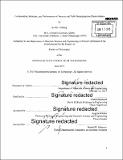| dc.contributor.advisor | Paula Hammond. | en_US |
| dc.contributor.author | Huang, Kevin J. (Kevin Joon-Ming) | en_US |
| dc.contributor.other | Massachusetts Institute of Technology. Department of Materials Science and Engineering. | en_US |
| dc.date.accessioned | 2015-09-17T19:09:03Z | |
| dc.date.available | 2015-09-17T19:09:03Z | |
| dc.date.copyright | 2015 | en_US |
| dc.date.issued | 2015 | en_US |
| dc.identifier.uri | http://hdl.handle.net/1721.1/98742 | |
| dc.description | Thesis: Ph. D., Massachusetts Institute of Technology, Department of Materials Science and Engineering, 2015. | en_US |
| dc.description | Cataloged from PDF version of thesis. | en_US |
| dc.description | Includes bibliographical references (pages 131-134). | en_US |
| dc.description.abstract | We describe the fabrication and study of bulk heterojunction solar cells composed of PbS quantum dots and TiO2. In particular, we study the effects that bulk heterojunction composition and structure have on resulting device performance. We find that PbS and titania are extremely evenly distributed throughout our bulk heterojunction devices, such that charge carriers generated anywhere within the blend are well within a carrier collection length of the charge separating driving force required to separate them and enable their collection. Of the compositions we studied, we found that devices with a TiO2 rich bulk heterojunction composition outperformed devices employing other compositions. As a result of the size difference between the PbS quantum dots and the titania nanocrystals which compose the blends, the likelihood of forming a truly complete, bicontinuous bulk heterojunction network is maximized at a TiO2-rich blend composition. We find that diffuse interfaces exist between adjacent layers of our devices as a result of interfacial surface roughness. Rather than being deleterious, this increased interfacial area extends the spatial extent of the depletion region over a greater volume of our devices. Our bulk heterojunction blends form well packed, high density binary particle mixtures, particularly at a TiO2-rich composition. Device efficiency was maximized for bulk heterojunctions employing the smallest titania nanocrystals, an indication that at constant volume fractions, larger titania nanocrystals decrease the total number of titania particles available to form complete and continuous pathways through the depth of the bulk heterojunction. Furthermore, a peak in device performance was observed at intermediate blend layer thicknesses. This results from the balance between two opposing effects: an increase in light absorption and photocurrent with thicker bulk heterojunctions and an increased likelihood of charge carrier recombination with thicker bulk heterojunctions. Finally, enhanced light absorption and current generation was observed at red and infrared wavelengths, validating the ability of bulk heterojunctions to spatially extend the reach of the charge separating driving force, such that the previously missed red and infrared photons may be captured. | en_US |
| dc.description.statementofresponsibility | by Kevin J. Huang. | en_US |
| dc.format.extent | 134 pages | en_US |
| dc.language.iso | eng | en_US |
| dc.publisher | Massachusetts Institute of Technology | en_US |
| dc.rights | M.I.T. theses are protected by copyright. They may be viewed from this source for any purpose, but reproduction or distribution in any format is prohibited without written permission. See provided URL for inquiries about permission. | en_US |
| dc.rights.uri | http://dspace.mit.edu/handle/1721.1/7582 | en_US |
| dc.subject | Materials Science and Engineering. | en_US |
| dc.title | Composition, structure, and performance of nanocrystal bulk heterojunction photovoltaics | en_US |
| dc.type | Thesis | en_US |
| dc.description.degree | Ph. D. | en_US |
| dc.contributor.department | Massachusetts Institute of Technology. Department of Materials Science and Engineering | |
| dc.identifier.oclc | 920878444 | en_US |
